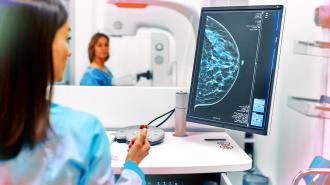In an attempt to encourage more people to get screened for breast cancer, one of the biggest medical imaging firms in the US has opened a walk-in mammogram clinic inside a Walmart.
The challenge: The average American woman has a 1 in 8 chance of developing breast cancer at some point in her life, and after lung cancer, it’s the top cause of cancer deaths among women in the nation.
One of the best ways to prevent breast cancer from becoming fatal is to catch it early, when treatments are most effective, and the best way to do that is to get regular mammograms, usually starting in your 40s.
“The pilot with Walmart is designed to provide even greater, convenient access for women.”
Howard Berger
Mammograms typically require setting up an appointment and visiting a clinic, though, which can be inconvenient, especially for people who are busy or live in rural areas.
Interpreting mammograms isn’t easy, either. There is a 7-12% chance of a false positive — something that gets flagged as possibly cancer but isn’t — after a mammogram. These false positives can lead to unnecessary stress as well as follow-up procedures, such as biopsies.
When you combine the hassle and potentially inaccurate results with the fact that mammograms can be uncomfortable or even painful, you get a lot of people who don’t get screened for breast cancer as often as they should, if at all.
What’s new? On December 8, radiology provider RadNet opened a walk-in mammogram clinic, called MammogramNow, inside a Walmart Supercenter in Milford, Delaware, kicking off an 18-month pilot program.
”[T]he pilot with Walmart is designed to provide even greater, convenient access for women, driving better compliance with annual breast cancer screening guidelines,” said RadNet President and CEO Howard Berger.
People who visit the clinic will have the option of having their mammograms analyzed by Saige-Dx, an AI trained to help doctors interpret the images — in a study involving 18 radiologists, the AI improved the accuracy of all 18 doctors’ readings.
“The improved performance was reflected in both an increase in the percentage of the cancers detected and a lower false positive rate when using Saige-Dx,” Bill Lotter, then-CTO and co-founder of DeepHealth, the RadNet subsidiary that developed the AI, said in 2022.
Looking ahead: RadNet told The Street it plans to open MammogramNow clinics at Walmarts in Hanford, California, and Phoenix, Arizona, in early 2024 and could add additional locations before the end of the pilot program in 2025.
“The ability to offer leading-edge hardware, software, and AI technologies in a non-traditional healthcare location, such as a highly-trafficked retail location like a Walmart Supercenter, could become a new paradigm for the future of consumer healthcare and preventative medicine,” said Berger.
We’d love to hear from you! If you have a comment about this article or if you have a tip for a future Freethink story, please email us at tips@freethink.com.
